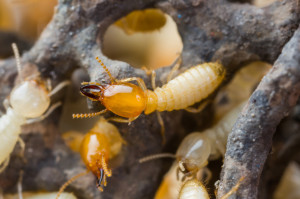Termites are an ongoing problem for Houston homeowners. Flourishing in the warmth and humidity of East Texas, they establish large colonies and get right to work eating the wood in our homes and landscaping. Springtime marks termite mating season when termites swarm to find new locations where they can establish additional colonies.
What are termites?
 Termites are small insects that live in colonies and feed on organic matter, particularly the cellulose found within the wood. In nature, they play an important role in helping decompose fallen trees. In your home, however, they can be destructive creatures that can weaken structures and damage foundations.
Termites are small insects that live in colonies and feed on organic matter, particularly the cellulose found within the wood. In nature, they play an important role in helping decompose fallen trees. In your home, however, they can be destructive creatures that can weaken structures and damage foundations.
There are three main types of termites in the US:
- Formosan Subterranean Termites
- Native Subterranean Termites
- Drywood Termites
Native subterranean termites eat everything from paper to cotton to wood. Because of their biology, they rely on microbes to help digest cellulose, so they are drawn to areas with rotting wood, such as mulch and dead trees. They also need significant moisture to survive, so they either remain in the moist soil or will nest in above-ground parts of buildings that have moisture collecting from leaking pipes, air conditioner condensation or gutters.
Formosan termites are similar to subterranean termites, but with larger colonies. Because of their increased numbers, they damage wooden structures faster than native subterranean termites. They also like to feed on new spring and summer growth of trees and shrubbery, and have been known to eat through non-organic materials searching for wood and moisture.
Drywood termites can be found everywhere in Texas, with the largest concentration of colonies in Houston and elsewhere along the Gulf Coast. As their name suggests, they prefer dry wood that is raised up from the ground and are found in siding, eaves, and the roof.
When Spring Hits, Termites Swarm
When spring rolls around, the days grow longer, the temperatures rise, and humidity levels increase. All of these environmental factors are like an alarm clock to these insects, triggering termite swarming season.
It takes a colony two to four years to become established and produce reproductive termites, which have wings and fly from their homes to build new colonies. In the spring, these termites commonly are found swarming around lights at night. Mating pairs that find suitable locations will lay eggs there to start up their new colony.
If you find swarming termites inside a house, that’s a good sign that there’s an infestation somewhere. Seeing them outside suggests there’s a nearby an infestation of a structure, landscaping, or a tree. Some of the trees in the Houston area include citrus, willows, Chinese elm, cedar, white oak and wax myrtle.
How can you protect your home from termites?
Termite colonies can be difficult to locate and eradicate fully. Make sure to remove all dead tree limbs, piles of wood and other inviting locations for termite colonies, and ensure that you don’t use wood mulches up against wooden fences or foundations. Also, check for areas that may remain damp throughout the year.
How bad is the termite problem in Houston?
In addition to native subterranean termites, for at least six years drywood termites have been spreading across Houston. Since these termites don’t need contact with the soil, they pose a significant threat to homes. While swarming termites don’t travel far, once they get established in a neighborhood they can be difficult to eradicate, since a single colony can have thousands of individual insects. Because of this, ABC Home and Commercial Services recommends annual inspections to make sure no termites have made your home their home.
What do I do if I find evidence of termites?
If you’ve seen swarming termites or think you might have an infestation, we recommend that you call out a professional to inspect your home and landscaping. Termite colonies can live up to 20 years and produce millions of termites, so you don’t want to take chances with do-it-yourself solutions.